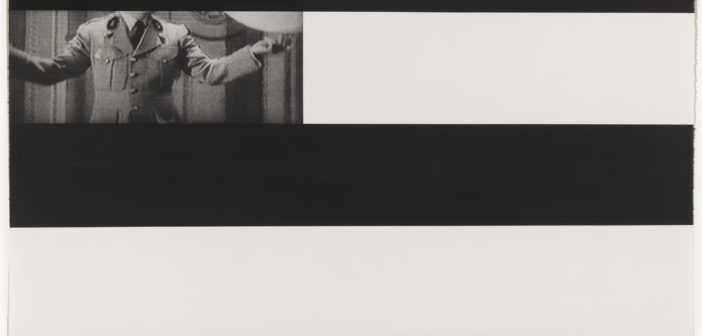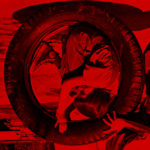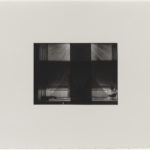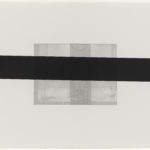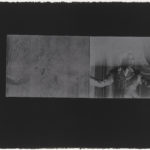
Artist Annette Lemieux, recipient of the Maud Morgan Prize
Ruth and Carl J. Shapiro Family Courtyard
January 12, 2017
*Photograph © Museum of Fine Arts, Boston
Artists take new directions in their work all the time: inspired anew by an idea, a medium untried, current events, or perhaps another artist’s work. Acclaimed international artist Annette Lemieux, known for decades for her conceptual, politically charged art, turned from two-dimensional to three-dimensional provocations out of necessity, at least initially. In 1983, while on the job as assistant to artist David Salle in New York City, Lemieux was struck by a car, resulting in a month-long stay in the hospital. The accident left her with a reduced capacity for the fine motor coordination necessary for the painting and drawing she had done since graduating from the Hartford Art School at the University of Hartford.
The accident turned out to be a fortuitous misadventure. Lemieux began to work with found objects and photography, often combining the two, and here is where she realized her calling as a conceptual artist. Today, Boston-based Lemieux (born in 1957) is known as one of the preeminent conceptual artists of her generation. Her work is included in museum collections across the U.S. and Europe, and she is the recipient of numerous prizes and fellowships, including two Whitney Biennials (1987 and 2000) and the 1990 Venice Biennale.
As Lemieux evolved as an artist, her work shifted to encompass ideas as much as aesthetics: and this, of course, is at the foundation of conceptual art. Mise en Scène, Lemieux’s first solo exhibition in Boston in more than 30 years, could be viewed as a merging of two- and three-dimensional expressions as a means to a conceptual end. As such, Mise en Scène seems to cohere a career’s worth of sensibilities, offering a compelling window into Lemieux and her work.
Lemieux, who came of age in the late 1970s and early 1980s in self-described small-town America, was deeply affected by the important political films of the 1960s. François Truffaut’s Fahrenheit 451 (1966), Robert Mulligan’s To Kill a Mockingbird (1962), Charlie Chaplin’s The Great Dictator (1940), and Fritz Lang’s M (1931) all inform this new body of work, bridging a child’s imaginative world with the development of ideas that would carry into her adulthood. The still images draw from socio-political aspects of the films in ways that resonate today: from the racial divide brought into the public consciousness in To Kill a Mockingbird to the satirical Hitler figure in Charlie Chaplin’s The Great Dictator. (Interestingly, Chaplin went into exile after the film came out; it seems no one got the joke, or perhaps it struck too close to home in the paranoid zeitgeist of the Cold War.)
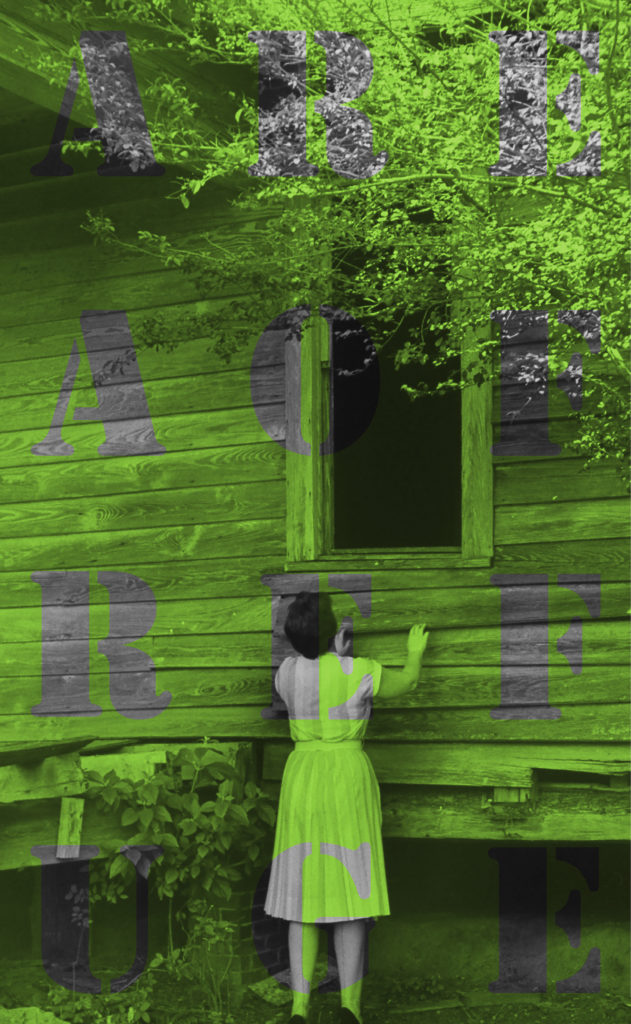
AREA OF REFUGE
Annette Lemieux (American, born in 1957)
2017
Pigment Inkjet on cotton
84 x 52 x 1 ¾ inches
*Courtesy, Museum of Fine Arts, Boston
In Area of Refuge (2017, pigmented inkjet on cotton), To Kill a Mockingbird author Harper Lee stands outside her childhood home, arms placed on the aged wooden structure as she gazes upward into a window. AREA OF REFUGE is stenciled in grid form across the green-hued surface. The image is both haunting and simple, and asks us to question notions of security and home.
Equally compelling, aesthetically speaking, is the two-dimensional diptych The Watchers (2017, pigment inkjet on cotton), in which a grid pattern of still images of spy devices and satellites is shown in color, and then black and white, with color bars in the lower right corner of each. Older viewers will recognize these from their rabbit-eared TV sets, the color bars intended to calibrate the color and audio via satellite.
The sculptural piece (Fire Cone) [sic](2017, wood, acrylic, light fixture, caster wheels), draws our attention further to issues of censorship and surveillance: in the film Fahrenheit 451, based on the Ray Bradbury classic, books are burned and citizens are under the watch of a nationalist authority. The white and red striped cone resembles a lighthouse, but instead of guiding ships to safety, steers intellectual discourse into the shadows.
Lemieux, true to form, explores a wide range of political and sociological issues, resonant of, and driven by, today’s dangerous backwards slide towards paranoia, a rejection of journalistic truth, and a vilification of the “other.”
Mise en Scène was conceived and created by Lemieux after being awarded the MFA’s prestigious Maud Morgan Prize, which honors Massachusetts women artists for their outstanding contributions to contemporary art. Lemieux continues to teach at Harvard University where she is Senior Lecturer on Visual and Environmental Studies.
Mise en Scène Annette Lemieux: Mise en Scène is on view through March 4, 2018, in the MFA’s Richard and Nancy Lubin Gallery. For information, visit www.mfa.org.
- SPIN Annette Lemieux (American, born in 1957) 2017 Pigment Inkjet on cotton, velvet Three panels at 32 x 32 x 1¾ inches; installation size approx. 64 x 128 x 1¾ inches *Courtesy, Museum of Fine Arts, Boston
- SPIN Annette Lemieux (American, born in 1957) 2017 Pigment Inkjet on cotton, velvet Three panels at 32 x 32 x 1¾ inches; installation size approx. 64 x 128 x 1¾ inches *Courtesy, Museum of Fine Arts, Boston
- SPIN Annette Lemieux (American, born in 1957) 2017 Pigment Inkjet on cotton, velvet Three panels at 32 x 32 x 1¾ inches; installation size approx. 64 x 128 x 1¾ inches *Courtesy, Museum of Fine Arts, Boston
- THE WATCHERS (left panel) Annette Lemieux (American, born in 1957) Curatorial Snapshot 2017 Pigment Inkjet on cotton Diptych, each measuring 126 x 52 x 1¾ inches; instillation approx. 126 x 122 x 1¾ inches *Courtesy, Museum of Fine Arts, Boston
- THE WATCHERS (right panel) Annette Lemieux (American, born in 1957) Curatorial Snapshot 2017 Pigment Inkjet on cotton Diptych, each measuring 126 x 52 x 1¾ inches; instillation approx. 126 x 122 x 1¾ inches *Courtesy, Museum of Fine Arts, Boston
- Censor (B) Annette Lemieux (American, born in 1957) Printed by: Robert Townsend, Harvard University, Carpenter Center for the Visual Arts Published by: Harvard University, Carpenter Center for the Visual Arts 1994 Photoetching printed in black and gray, one from the portfolio of five prints *Promised gift of Richard E. Caves *Courtesy, Museum of Fine Arts, Boston
- Censor (C) Annette Lemieux (American, born in 1957) Printed by: Robert Townsend, Harvard University, Carpenter Center for the Visual Arts Published by: Harvard University, Carpenter Center for the Visual Arts 1994 Photoetching printed in black and gray, one from the portfolio of five prints *Promised gift of Richard E. Caves *Courtesy, Museum of Fine Arts, Boston
- Censor (D) Annette Lemieux (American, born in 1957) Printed by: Robert Townsend, Harvard University, Carpenter Center for the Visual Arts Published by: Harvard University, Carpenter Center for the Visual Arts 1994 Photoetching printed in black and gray, one from the portfolio of five prints *Promised gift of Richard E. Caves *Courtesy, Museum of Fine Arts, Boston
- Censor (E) Annette Lemieux (American, born in 1957) Printed by: Robert Townsend, Harvard University, Carpenter Center for the Visual Arts Published by: Harvard University, Carpenter Center for the Visual Arts 1994 Photoetching printed in black and gray, one from the portfolio of five prints *Promised gift of Richard E. Caves *Courtesy, Museum of Fine Arts, Boston

